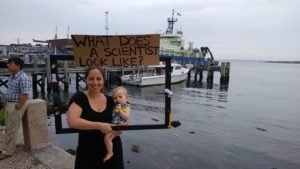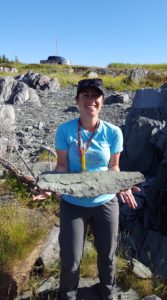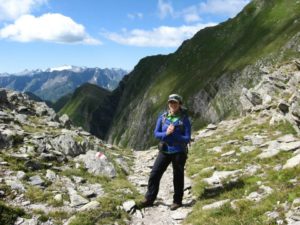Emily Cooperdock
Dr. Emily H. G. Cooperdock is an Earth Scientist who uses geochemistry and thermochronology to quantify the timing and rates of tectonic processes, with a special interest in the interplay between tectonic and geochemical cycles. Her PhD work focused on method development for thermochronology, which opened up new research avenues into processes that were historically difficult, or impossible, to directly date. She uses these tools to investigate the timing and rates of fluid-rock interactions – a process that changes the strength and chemistry of rocks, and occurs at all major plate boundaries and within faults.
Emily’s path to Earth Science is a bit unique; growing up with a dad who is a geochemist, she spent her childhood around scientists and mass spectrometers. Still, she wasn’t convinced that Earth Science was for her. She started ‘undecided’ at Columbia University taking a range of humanities classes, avoiding science for the first year. She knew that she loved hiking and working outdoors – after graduating from high school, she volunteered for AmeriCorps with the Nevada Conservation Corps, and she thru-hiked the 2200-mile Appalachian Trail after college. But, it was on an undergraduate field trip to Death Valley that she discovered she also enjoyed slowing down and reading the rocks. Her interest in tectonics and geochemistry developed in her intro geology class, when she was captured by how plate tectonics so eloquently explained the surface expression of major mountains, earthquakes, and volcanoes, and by geochemistry’s ability to fingerprint processes that we can’t observe in real time. She was particularly intrigued by the mantle, but figured she wouldn’t end up studying it because she wanted field work to be a fundamental component of her research and the mantle is, after all, below the crust. She was delighted to learn that large amounts of the mantle are exposed on Earth’s surface thanks to exhumation (typically at plate boundaries). Even more intriguing is that the mantle rocks are unstable at Earth’s surface, so that in the process of exhumation they are transformed from a strong, dense, dry rock into a weaker, less dense, wetter rock – a process called serpentinization. Her PhD research focused on developing a technique that could directly date minerals within serpentinites to understand the timing and cooling history of mantle exhumation and alteration. This work took her to Greece, the Swiss Alps, and Oman.

Emily and her daughter, Razia, at the Woods Hole Science Stroll, volunteering for the 500 Women Scientists.
As a postdoctoral scholar at Woods Hole Oceanographic Institution, Emily continued and expanded her research to tackle a range of scientific questions – from the age and development of oceanic crust to trace element cycling. This summer, Emily starts as an Assistant Professor at the University of Southern California, where she is building her own thermochronology laboratory and starting off with two awesome women PhD students!
In 2018, Emily co-authored a commentary with a close friend and peer, Rachel Bernard, on the past 40 years of racial and gender diversity in the geosciences, a topic that interested both of them throughout their PhDs. Around that same time, Emily had her daughter, Razia, and became acutely aware of the support systems (or lack thereof) in place for parents on academic career paths. As she transitions from
graduate student to postdoc to professor, she continues to advocate for increased diversity and culture change by facilitating community discussions, mentorship, and research into these topics. ESWN stands out as an amazing resource for women navigating a scientific career, one that Emily has taken advantage of multiple times. In addition, 500 Women Scientists has been an excellent organization to be involved with for advocating policy change at the institutional and national level. She is excited to see what awaits at USC and how she can impact change as she continues to through the pipeline, with the goal of leaving the system better than she found it.


